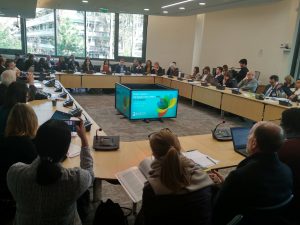Paris, France – The Reality of Aid Network (RoA), a pre-eminent South-led global network of CSOs advocating for people-centered aid policies and practices, reports that official development assistance (ODA) is deficient and misdirected to achieve the Sustainable Development Goals (SDGs). Its RoA Report 2018, “The Changing Faces of Aid and Development Cooperation: Encouraging Global Justice or Buttressing Inequalities?” looks into the global trends of the last two years, and presents case studies as evidence, and was launched on 16 January 2019 in the midst of the OECD Private Sec tor for Sustainable Development Conference.
Paul Horrocks, Senior Policy Analyst on Blended Finance at the OECD Development Co-operation Directorate, welcomed the participants by introducing The Reality of Aid Network and citing previous RoA Report Launches at the OECD. He also showcased the DAC and RoA’s close cooperation in the past year to develop the DAC-CSO Dialogue Framework, which now institutionalizes interactions between the DAC and civil society as part of the DAC reform process.
ROA Africa’s Vitalice Meja, in his keynote address, underscored that aid resources are woefully insufficient and often misdirected. Instead of following the Agenda 2030’s directive of leaving no one behind, aid seems to be being used to increase inequality. He emphasized that aid must be substantially increased but for effectively addressing the challenges in both least developed and lower-middle income countries. He urged the DAC to find ways of increasing aid, and the development community to continue asking fundamental questions of who’s interests are being served in the use of aid.
Leo Atakpu from ANEEJ Nigeria, presented the ROA 2018 Report as part of ROA’s commitment to monitor the performance of development aid and cooperation from the lens of poverty reduction and human rights. Like all past reports, the 2018 Report draws lessons and conclusions from both positive and problematic practices, which in turn inform key messages on the role and future of ODA in financing for development.
Benjamin Hunter from King’s College London talked about how the current trend on the promotion of private investment in healthcare companies has made many healthcare services completely out of reach of the vast majority of populations. He urged the development community to call for a pause on investments in healthcare, review the pro-poor effects of their healthcare investments, and introduce decision-making frameworks to ensure that investments benefit rather than exclude the poor.
Presenting the realities from the South, Jiten Yumnam of the Center for Research and Advocacy Manipur, illustrated how several projects dominated by DFIs and the private sector adversely affect indigenous communities. In the case of North East India where he comes from, the geothermal and wind farm projects have caused several human rights violations and environmental degradation. Corporations involved, he pointed out, are left unaccountable, many of which are from the DAC member-countries.
Audiences warmly welcomed the report and thanked ROA and its contributors for providing CSO, especially Southern perspectives on the policy and practice of aid and development cooperation. Responding to the question on the catalytic role of aid, Meja explained that it is about how much crowding in can be done with the small amount of aid, which contradicts the very essence of aid as it should be addressing the fundamental needs of people living in poverty and to create a better living condition. He further challenged the notion of applying such concepts on the use of ODA and raised the importance of having democratic ownership of national development plans.
 Mr. Rahul Malhotra, Head of Division, Reviews, Results, Evaluations and Development Innovation Division of OECD’s Development Co-operation Directorate, acknowledged that ODA has unique characteristics and potential contribution to achieve the 2030 Agenda.
Mr. Rahul Malhotra, Head of Division, Reviews, Results, Evaluations and Development Innovation Division of OECD’s Development Co-operation Directorate, acknowledged that ODA has unique characteristics and potential contribution to achieve the 2030 Agenda.
He said, however, that ODA is not marginalized nor being dismissed given the many multi-stakeholder conversations happening daily in DAC member countries, and “the immense value that is being added by ODA in some of the most difficult environments and on some of the most of the binding constraints to development.”
On the other hand, he said that based on the trends identified in the ROA Report in respect to where ODA is going, “it’s fair to conclude that overall ODA allocations are not yet reaching the needs of the furthest behind.”
He also pointed to the DAC members really acknowledging and seeking to identify ways of addressing the shrinking space for civil society and in the fact that scrutiny exists. “We should continue with the checks and balances, and continue investing in the evidence of what’s working and what does not, and showcasing that and debating that across constituencies.”
ROA, as part of its tradition, ended the launch by taking the opportunity to thank outgoing Chairperson Leo Atakpu and welcome his successor – Urantsooj “Urna” Gombosuren. ROA also thanked its members, partners, and the close to a hundred people from OECD, governments, the private sector, CSOs and academe who came to the launch.

